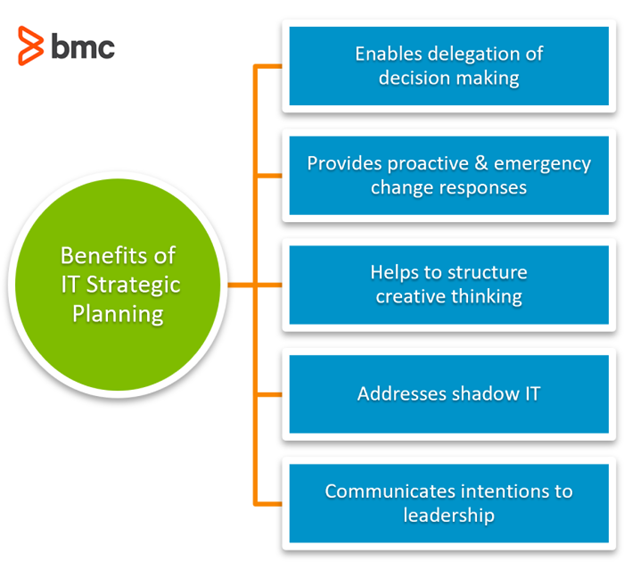If you’re an IT manager, chances are good you’ll be involved in IT strategic planning during your career. Sometimes strategic planning goes well. Sometimes it doesn’t. And strategic plans are often filed away in cloud storage, seldom referenced and hardly ever used.
Which begs the question: if no one uses your IT strategic plan, why bother creating one?
IT strategic planning has several significant benefits—even when the plan is seldom looked at. Today, we’ll discuss why it’s important to have an IT strategy and what IT strategic planning does for an organization. Specifically, we’ll look at:
- What is an IT Strategy?
- What an IT Strategy isn’t
- Critical benefits of an IT strategy
What is an IT strategy?
Stephen Covey popularized the phrase “begin with the end in mind.” This phrase captures the spirit of a strategic planning process. If we do not know where we want to be in 3-5 years, how do we ever stand a chance of getting there?
An IT strategy defines your IT vision and creates a strategic roadmap for using information technology, digital assets, and technical knowledge to create organizational value (i.e., its strategy). As we’ve written before, your IT strategy answers one particularly important question for your organization:
What IT changes are demanded to align IT with our organizational goals, support our business strategy, and create value for the organization?
Looked at this way, IT strategic planning is the process that gets us out of our day-to-day thinking. It focuses on the important—not the urgent. An IT strategy creates a mechanism for achieving our most important goals.
(For more information on what an IT strategy is and what it should include, check out How to Create an IT Strategy: Getting Started.)
Successful IT strategies
It’s just as important to understand what an IT strategy isn’t as well as what it is. Successful IT strategies are:
Strategic, not tactical
A strategic plan is a framework that guides an organization in making decisions and implementing solutions that create meaningful value, support the business strategy, and meet organizational goals. It focuses on the IT vision, processes, organization, and infrastructure, the whats and whens of aligning IT with its business goals and increasing IT capability.
Tactical plans focus on specific information for what must be done (the hows of executing the strategy). Tactics support your strategy and can rapidly change over time. Strategic plans often fail because they focus on tactics, not the strategy itself.
(Read more about IT/business alignment.)
Dynamic, not static
An IT strategy is a process not a one-time event. Your strategy shouldn’t be saved on write-once storage; It must be revised on a regular basis.
Our own personal preference is to write a 5-year strategic plan every year.
A strategic plan should allow for updates, and it must adapt to changes in the market. A strategic plan considers what the future may hold and aligns IT and business resources today to support that vision. By regularly reconsidering what the future should look like, you can make small manageable course corrections rather than having to “right the ship” when unexpected change occurs.
Published with limits, non-restrictive
In our next section, we’ll go over several benefits an IT strategy provides. Implicit in these benefits is the assumption that the published IT strategy is available to all affected staff. Upper-level management shouldn’t be the only ones who understand the IT strategy.
Except for confidential information, anyone expected to implement the strategy should understand the strategy. Your IT strategy should be shared, not restricted.

Benefits of an IT strategy
A well-conceived IT strategy provides the following benefits:
- Enables delegation of decision making
- Provides proactive and emergency response to change
- Provides parameters for creative thinking
- A way to addresses shadow IT
- Communicating intentions to leadership
Let’s take a look at each benefit.
Enabling delegation of decision making
Decision making is one of the most challenging things for a manager to delegate. Despite our best efforts, it’s often difficult to get our employees to think the same way we do.
A well-written strategic plan provides a framework for IT decision-making. When making decisions, employees can use the strategic plan to ask, “Is what I’m doing in line with the plan (wishes of the organization)?” or “Is what I’m doing opposed to the plan?”
A strategic plan empowers employees to make decisions and move initiatives forward without management involvement in every decision. This in turn helps to create a more agile, faster moving organization.
Provides proactive & emergency responses to change
A strategic plan helps an organization in two ways.
- First, it lays out the vision, requirements, critical initiatives, and directions IT will take to meet business strategies and goals. Strategic planning encourages planning based on organizational priorities.
- Second, a strategic plan also allows us to be better prepared for unexpected change and emergencies. Strategic objectives can be used to respond to unanticipated changes as well as to promote growth.
One example might occur when in-house file server storage space unexpectedly fills up at the same time the strategic plan calls for cloud storage migration. Being familiar with the strategic plan, your team may have implemented a pilot project for cloud storage and can move up storage migration in response to the disk issue. In this case, strategic thinking prepares for efficient responses.
(Learn more about regular & emergency change.)
Provides parameters for creative thinking
When developing solutions to organizational challenges, sometimes a blank slate is too much leeway. Think of building a house. Most of us do not start with a stack of lumber and a box of nails. We rely on a builder who has several floorplan options to start with.
This is analogous to a strategic plan. Once we have a plan, we can have conversations about what we like and what we do not like. We can also talk about features and how the system will be used. Before long, a house (system) that meets our needs starts to take shape.
You will find that problems can be addressed much more quickly when everyone has at least a basic understanding of where the organization wants to go. Planning sessions can more easily be focused on capabilities and not get caught up in “lumber selection” that has minor impact on the larger goals.
Offers a way to address shadow IT
Many organizations have seen a rise in shadow IT in recent years. In its simplest definition Shadow IT is an IT function/application/department created by individual units that are unaffiliated with the official (or central) IT department.
Shadow IT evolves in organizations oftentimes because IT departments are not agile enough or are not meeting the needs of the smaller departments in large organizations. A strategic plan can allow an organization to discover why Shadow IT exists and incorporate that need into the overall goals. Oftentimes a great method of dealing with shadow IT is to acknowledge the need and gain support for bringing them into the main IT organization.
(Read more about shadow IT, including its risks & surprising opportunities.)
Communicates intentions to leadership
A strategic plan for IT is the single most valuable tool for communicating your intentions to senior leadership. High level strategy is what senior leaders are most concerned with in organizations. Having a documented plan allows you to have conversations with C-Level executives about your goals.
Most importantly it provides senior leadership the opportunity to redirect any of your efforts that might not be 100% in line with their vision. These conversations allow senior leadership to establish an understanding of what the IT department is doing without having to be involved in day-to-day operations.







